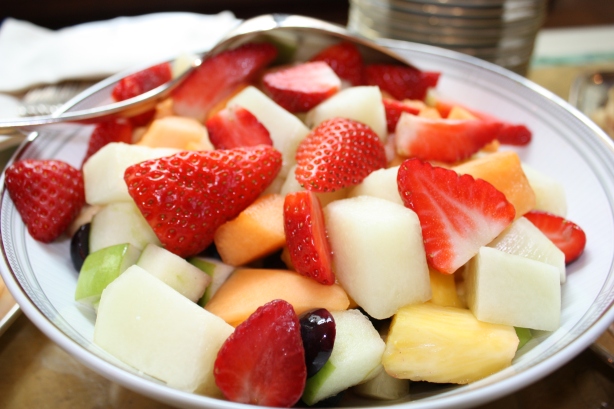
Photo of kitchen garden courtesy of Burpee Seeds.
Spring is in the air and the smell of Spring makes me think of vegetables…I know, it’s a curse…
You’ve most likely have heard me drone on in the past about the disconnect between recommendations of vegetables for optimal health and the actual consumption of them. I often think, “What do we need to do [as health professionals] to get people to eat more produce? Maybe if vegetables got together and organized, like the toys did in Toy Story, people might be scared enough to start eating them…or at least treating them with some sort of respect?”
Looks like George Bail Jr. from Burpee Seeds had similar thoughts when he drafted up this brilliant Bill of Vegetable Rights or “We, the Vegetables…” Enjoy!
Bill of Vegetable Rights or “We, the Vegetables”
It is our duty and our privilege to once and for all declare our Bill Of Rights as vegetables. For too long we have maintained a dignified silence in the face of human neglect, abuse and outright insult bordering on the libelous.
For 10,000 years we have nourished ungrateful people with uncountable harvests of delectable, nutritious food. Humankind must now grant vegetables the respect, consideration and care we merit.
For far too long, humans have relegated us to the side dishes of life. In the theatre of cuisine, vegetables serve as supporting players with mere walk-on roles, rather than the culinary stars we surely are.
The Congress of Vegetables hereby claims our God-given rights, and demands that people at last respect us for not only our nutritional value, flavor and texture, but also our distinctive personalities and panoply of colors and shapes.
Our human friends must acknowledge the indispensable role vegetables have played in their history and survival. Consider this: were it not for annual vegetables, people would not exist. Chew on that!
THE RIGHT TO RECOGNITION
Humans have an unhappy propensity for viewing vegetables as mere things, commonplace objects on offer in the produce department.
In the pantheon of human culture, we make a poor showing indeed. Where are the monuments, museums, poems, novels, films and symphonies inspired by vegetables?
Your Proust wrote several long, elaborate novels inspired by the bite of a madeleine—a cookie. Imagine how much greater his opus would be if he had dined on an artfully prepared eggplant.
What if, in Shakespeare’s “Hamlet,” the Prince’s soliloquy was addressed to an artichoke? Why not? Is the fear the artichoke would eat up the scenery? Or that Hamlet would eat up the artichoke?
In your entertainments, humans anthropomorphize—imbue with human traits—every kind of thing or creature. In ancient fables and today’s cartoons, humans take on the guise of all manner of creature—woodpeckers, rabbits, rodents, cats, spiders, elephants, dogs, chipmunks and sponges—all, evidently, plausible vehicles for human expression.
The names of your venerated sports teams are inspired by giants, birds, brigands, snakes, metals, jungle creatures, warriors and meat-packers. In vain we look for the California Cauliflowers, Tucson Turnips or New York Yams. Cruelly, inexplicably, you refuse vegetables entrée to the garden of the human imagination.
Your diminution of vegetables diminishes all of us. So build temples to vegetables. Enshrine the role of vegetables in heroic legend. May a conqueror have the dignity to confess, “Were it not for vegetables, defeat would have been inevitable.”
THE RIGHT TO RESPECT
In so-called industrial western societies, vegetables play an ever-smaller role in people’s diet. Adults and children consume a fraction of the vegetables their bodies demand—a development with significant health and economic consequences.
Food manufacturers and restaurant chains apply considerable expense and ingenuity convincing the public to eat un-nutritious fat-laden products unworthy of the designation “food.”
Can it be difficult to convince the public of the appeal of us vegetables—which benefit your waistline, improve your appearance, enhance your well-being and prolong your life?
In the widespread agonizing over America’s obesity crisis, rarely mentioned is the problem’s antidote: Eat More Vegetables.
In the endless bickering over health insurance, did a legislator stand up in Congress to wax eloquent on wax beans and their vegetable cousins? Not that we remember. Looking for highly affordable health insurance? Remember this: “V for Vegetables!”
THE RIGHT TO CREATIVITY
Helping bring about vegetables’ wretched showing in the human imagination and daily diet is the way we are prepared.
In fact you humans don’t prepare vegetables, so much as abandon us to a merciless pot of boiling water or the brutality of the broiler. Our adieu is swift and unsentimental. Thanks to culinary creative destruction, you sacrifice our luscious color, sensuous texture, voluptuous flavor and spectrum of succulent sensations. Still worse, your children come to regard vegetables as flavorless, lifeless things.
Today, it is true, vegetables enjoy a new vogue in culinary circles. At chic and expensive restaurants, we are transitioning from side dishes to entrées created with nuance and artistry.
Perhaps, for once, vegetables are escaping the stigma of being a duty, the anti-charisma bestowed on all things “good for you.” For once—for once!—we are being regarded as sensual, pleasurable and worthy of temptation. “To the ramparts!”
On this first day of spring, these are the dreams—and the rights—of the undersigned: a vegetable patch in every home, schoolyard and community garden.
Signatories:
THE BULB VEGETABLES
Chives, Garlic, Leeks, Onions, Scallions, Shallots, Water Chestnuts
FRUITED VEGETABLES
Avocados, Chayote, Cucumbers, Eggplant, Melons, Okra, Olives, Peppers, Squash, Tomatoes, Tomatillos
INFLORESCENT VEGETABLES
Artichokes, Broccoli, Cauliflower
LEAFY VEGETABLES
Arugula, Brussels sprouts, Cabbage, Chicory, Chinese cabbage, Collards, Cress, Dandelion nettles, Endive, Lamb’s lettuce, Lettuce, Nasturtium, Purslane, Radicchio, Savoy, Sea kale, Sorrel, Spinach
PODDED VEGETABLES
Beans, Peas
ROOTED VEGETABLES
Beets, Burdock, Carrots, Celeriac, Malanga, Parsnips, Radishes, Rutabaga, Salsify, Turnips
STALK VEGETABLES
Asparagus, Bamboo, Cardoon, Celery, Chard, Fiddlehead, Fennel, Kohlrabi
TUBEROUS VEGETABLES
Cassava, Crosne, Jerusalem artichoke, Jicama, Potato, Sweet potato, Taro, Yam






